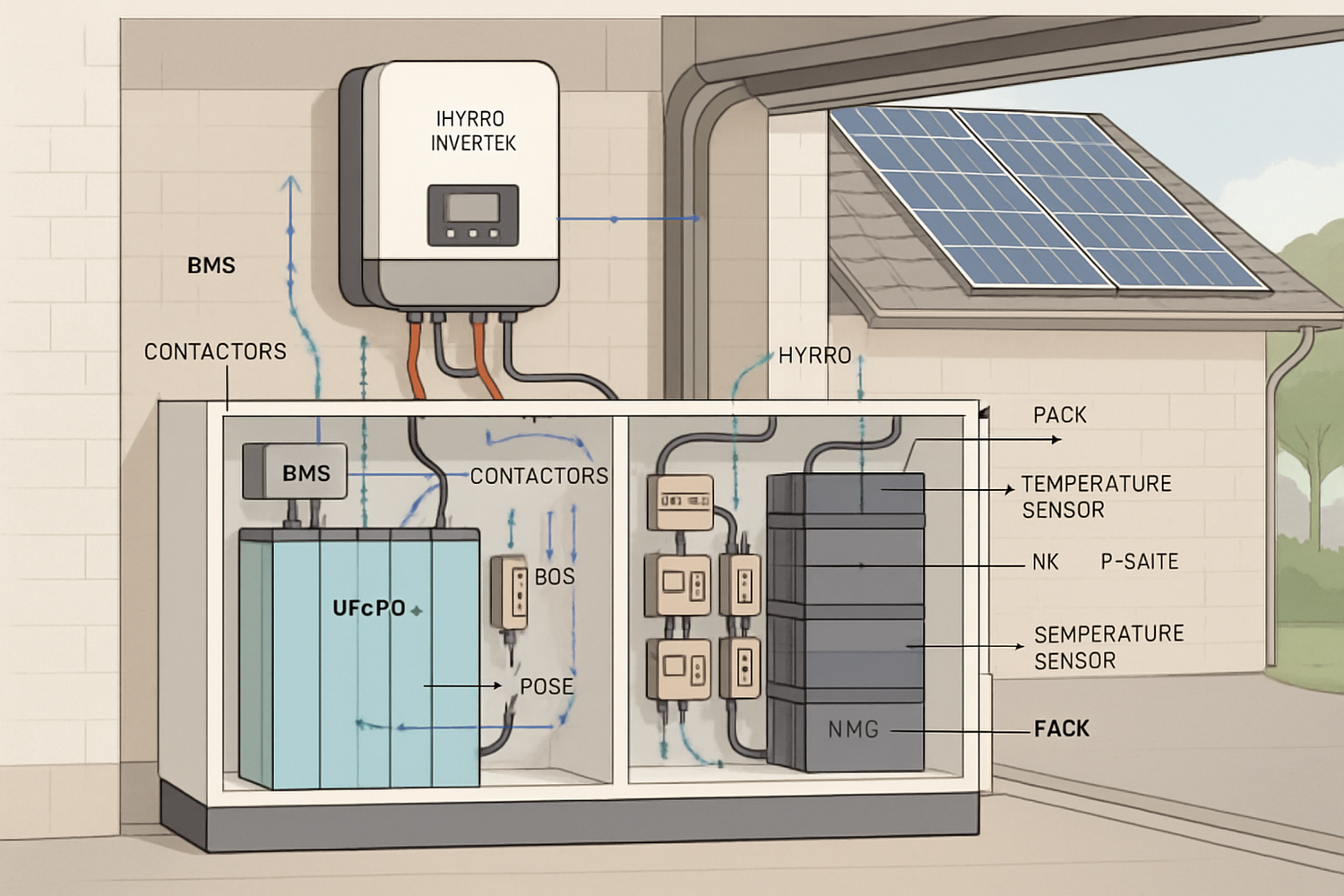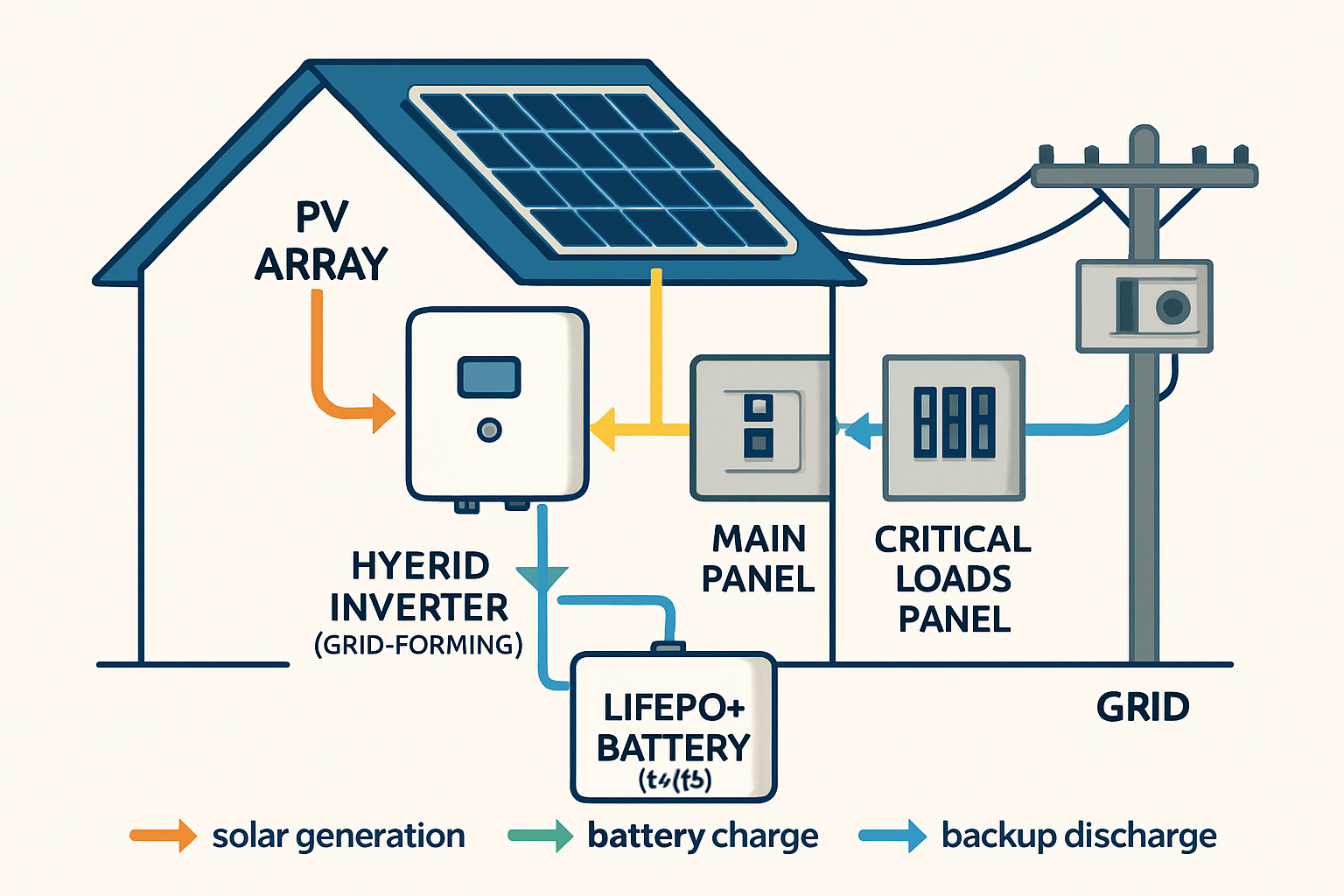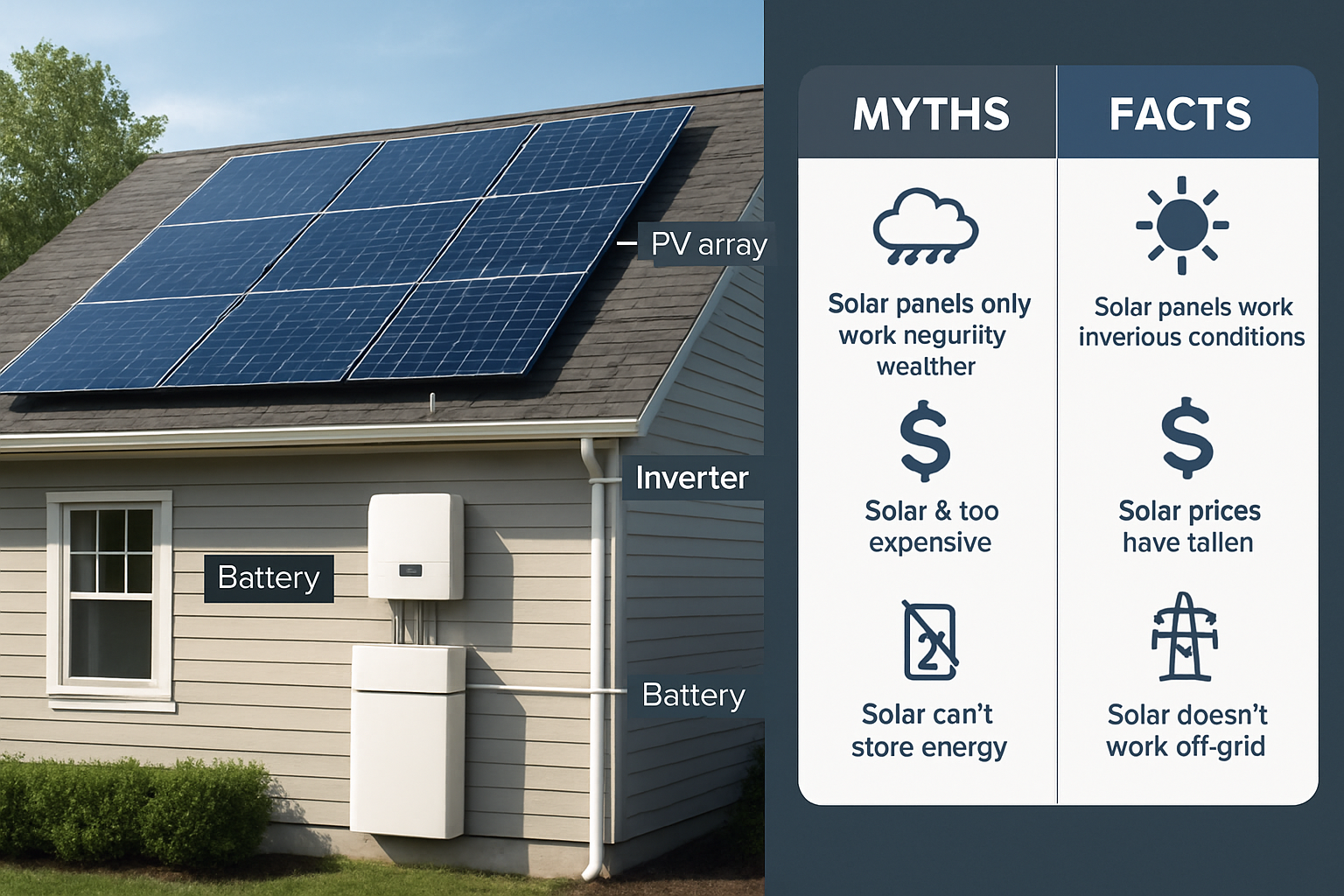Solar Myths vs Facts: Battery safety sparks debates in every home solar ESS discussion. You will see strong claims on both sides. This piece separates Battery Safety Myths from practical, testable facts. We focus on LiFePO4 vs NMC safety in residential use, the role of system design, and choices that reduce risk without sacrificing performance.

What makes a battery “safe” in a home ESS
Safety is not a single feature. It is chemistry, pack design, controls, and installation working together. Lithium chemistries differ, yet a well-engineered system can manage risks across types.
- Chemistry and inherent stability: LiFePO4 (LFP) has a strong olivine crystal structure and lower oxygen release, which raises the temperature needed to trigger thermal runaway. NMC offers higher energy density but typically lower thermal runaway onset.
- Battery Management System (BMS): A robust BMS limits voltage, current, and temperature, balances cells, and disconnects the pack during faults. It is the first line of defense against abuse and aging-related issues.
- Thermal and mechanical design: Cell spacing, flame-retardant barriers, vents, and thermal paths slow propagation. Passive or active thermal management keeps cells inside safe operating windows.
- Standards and installation: Systems tested to recognized methods (such as UL 9540A for fire propagation testing) and installed per local codes reduce hazards. Clearances, anchoring, disconnects, and signage matter.
Global agencies also highlight the value of strong system practices. According to the International Energy Agency, storage deployment is rising quickly, which puts a premium on standardized safety approaches across the supply chain. The International Renewable Energy Agency discusses how storage improves grid flexibility while calling for robust technology-agnostic safety frameworks to enable scaling. The U.S. Energy Information Administration reports growing attachment of batteries to residential solar, underscoring the need for consistent installation practices. The U.S. Department of Energy stresses that lithium-ion systems rely on BMS controls, proper ventilation, and temperature management to manage risk.
LiFePO4 vs NMC safety: what really changes in practice
Electrochemistry and thermal runaway thresholds
Thermal runaway is a rapid, self-heating event. Typical onset ranges differ by chemistry and design:
- LiFePO4: about 220–260°C for onset under abusive conditions, aided by low oxygen release from the cathode structure.
- NMC: about 150–210°C for onset depending on exact nickel content, electrolyte, and pressure.
These are typical laboratory ranges. Pack-level behavior depends on cell format, heat dissipation, and protections. Well-designed packs aim to prevent reaching those temperatures through current limits, temperature monitoring, and shutdown logic.
Energy density and packaging
NMC commonly stores more energy per kilogram. That can reduce cabinet footprint. It also concentrates energy, so thermal design and spacing are crucial. LiFePO4 trades some energy density for thermal stability. In a residential utility room or garage, LFP’s larger footprint is often a fair trade for lower propagation risk.
Cycle life, aging, and safety margin
Cells change over time. Internal resistance rises with cycles and heat. That increases heat during charge and discharge. LFP packs often offer longer cycle life at higher depth of discharge. NMC packs can deliver high power and energy density but may need tighter thermal control as they age. A conservative design keeps both chemistries in a safe window for years.
| Parameter | LiFePO4 (LFP) | NMC | Safety Notes for Home ESS |
|---|---|---|---|
| Typical energy density (cell) | 120–160 Wh/kg | 180–250 Wh/kg | NMC saves space; LFP is bulkier but easier to cool at equal kWh |
| Thermal runaway onset (typical) | ~220–260°C | ~150–210°C | LFP offers higher thermal threshold; pack design still decisive |
| Cycle life (to ~80% capacity) | ~3,000–6,000 cycles | ~1,500–3,000 cycles | Long life supports stable performance and lower heating from aging |
| Nominal cell voltage | 3.2 V | 3.6–3.7 V | Inverter compatibility and BMS calibration matter |
| Cold temperature behavior | Needs preheat for charging below 0°C | Also limited; active heating recommended | Pack heaters and charge limits protect cells |
| Cost per kWh (pack level) | Typically lower | Typically higher | Varies by market and supply chain |
As deployment grows, industry practice improves. The IEA notes rising investment in storage manufacturing and better production quality. The IRENA highlights that battery safety depends on system integration and standards adoption, not only chemistry choice. The DOE reiterates the role of thermal management and BMS in preventing abuse conditions that lead to runaway.
Battery Safety Myths vs Facts
Myth: “All lithium-ion batteries are the same.”
Fact: LFP and NMC behave differently under heat and abuse. LFP has higher thermal thresholds. NMC delivers higher energy density. Safety outcomes depend on both chemistry and pack engineering, including BMS, spacing, and enclosure materials.
Myth: “LiFePO4 can never catch fire.”
Fact: LFP offers strong thermal stability, but no chemistry is immune to abuse. Overcharging, external short circuits, crushed cells, or exposure to fire can trigger hazardous events. Good packs add multiple layers of protection: fuses, contactors, sensors, and software limits.
Myth: “NMC is unsafe for homes.”
Fact: Certified NMC systems can meet strict propagation and enclosure standards. Thermal barriers, gas management, and shutdown logic help contain faults. Correct installation and ventilation are just as important as chemistry choice.
Myth: “Higher energy density automatically means higher risk.”
Fact: Energy density raises engineering demands. It does not doom a system. With robust pack-level mitigation, NMC can run safely in space-constrained sites. Many homeowners still favor LFP for its wider thermal buffer and long life.
Myth: “If a pack has a BMS, chemistry no longer matters.”
Fact: The BMS is critical, but chemistry sets the baseline. LFP’s stability gives the BMS more room to act. With NMC, designers often add tighter limits and more aggressive cooling. Both need careful settings, validated by certification tests.
Design choices that cut risk in Home Solar ESS
Pick the right chemistry for the site
- LiFePO4: Strong pick for garages, utility rooms, and retrofits where space is available. Long cycle life supports daily cycling from solar. Many homeowners accept the larger cabinet for peace of mind.
- NMC: Useful where space is tight or weight limits apply. Requires disciplined thermal design and certified enclosures. Consider NMC in apartments or compact indoor spaces only if the system meets stringent installation requirements.
Insist on a comprehensive BMS
- Protections: over/under-voltage, overcurrent, short-circuit, over/under-temperature.
- Active or high-quality passive cell balancing with logged data.
- Redundant temperature sensors embedded in modules, not just on the surface.
- Contactors, pyro-fuses, and clear fault states that isolate the pack quickly.
- Communications: CAN/RS485 to the inverter with validated protocols.
Thermal and mechanical safeguards
- Thermal pads, flame-retardant separators, and cell spacing sized for the chemistry.
- Passive vents or filtered paths to manage off-gassing in fault conditions.
- Heaters for cold climates to allow safe charging in winter.
- Ingress protection suitable for the room (e.g., dust in garages).
Installation practices that matter
- Follow local codes and inspection requirements. Look for certifications and test reports (e.g., fire propagation testing).
- Mount on noncombustible surfaces with recommended clearances and anchoring.
- Provide a visible disconnect and correct overcurrent protection between battery and inverter.
- Keep away from flammable liquids and direct heat sources.
- Enable remote monitoring with fault alerts via app or gateway for fast response.
Public agencies encourage safe siting and integration. The DOE emphasizes proper installation and ventilation for residential storage. The EIA notes increasing use of batteries with home solar, making these practices part of mainstream residential energy planning.
Practical sizing and use cases
Daily solar self-consumption
Household uses 10 kWh each evening. With a 5 kW array, sizing a 15 kWh LiFePO4 pack at 70–80% usable capacity keeps the battery within a gentle depth-of-discharge window. That improves cycle life and reduces heat during charge and discharge. A hybrid inverter links PV, battery, and loads, shifting solar into evening hours and providing backup.
Backup for grid outages
Select chemistry based on runtime and safety margin. LFP’s predictable behavior across long cycle life is attractive for frequent outages. If space is limited, a compact NMC cabinet may fit, provided ventilation and clearances meet code. Add load management to prioritize critical circuits and keep currents lower, which decreases heating.
Off-grid cabins and farms
Cold environments limit charge capability in both chemistries. Choose batteries with integrated heaters and a BMS that blocks charging until cells are warm. For a remote cabin, an LFP bank with generous capacity reduces depth of discharge and charge rates, keeping temperatures stable. Off-grid solar solutions can combine panels, a hybrid inverter, and LFP batteries for simple integration.
Where our product philosophy fits
We focus on practical safety gains that homeowners can see and measure. Our lithium battery line centers on LiFePO4 for high stability and reliable performance. Our home ESS integrates LFP batteries, a hybrid inverter that converts DC to AC, and rooftop solar into a single, managed system. For off-grid sites, modular cabinets scale from small cabins to larger farm loads. Each system applies layered safety: certified cells, disciplined BMS logic, mechanical protection, and remote monitoring. You get scalable capacity and a calm operating profile suited to daily cycling.
How to cut through Battery Safety Myths in purchasing
- Ask for cell chemistry and exact format (prismatic, pouch, or cylindrical) and how the pack manages heat.
- Review BMS features and fault isolation methods. Confirm temperature sensor count and placement.
- Request fire propagation test summaries and system certifications.
- Check inverter-battery communication and validated settings for float, absorption, and cutoff.
- Plan siting with clearances, ventilation, and noncombustible mounting surfaces.
- Use conservative sizing to reduce peak currents and heat.
Key takeaways
- LiFePO4 vs NMC safety differences are real but manageable with good design.
- LFP offers higher thermal stability and long cycle life, attractive for home solar ESS.
- NMC can be safe in certified systems, especially where space is tight, with strong thermal controls.
- BMS quality, thermal design, and correct installation often matter more than chemistry alone.
- Choose the configuration that fits your site and risk profile, then insist on test data and proper installation.
Global energy bodies continue to call for robust storage safety practices as adoption grows. See the IEA for storage market perspective, IRENA for integration frameworks, EIA for residential solar and storage trends, and the DOE for system-level safety priorities. With facts over myths and careful engineering, home solar ESS can deliver reliable, low-stress energy every day.





Leave a comment
All comments are moderated before being published.
This site is protected by hCaptcha and the hCaptcha Privacy Policy and Terms of Service apply.